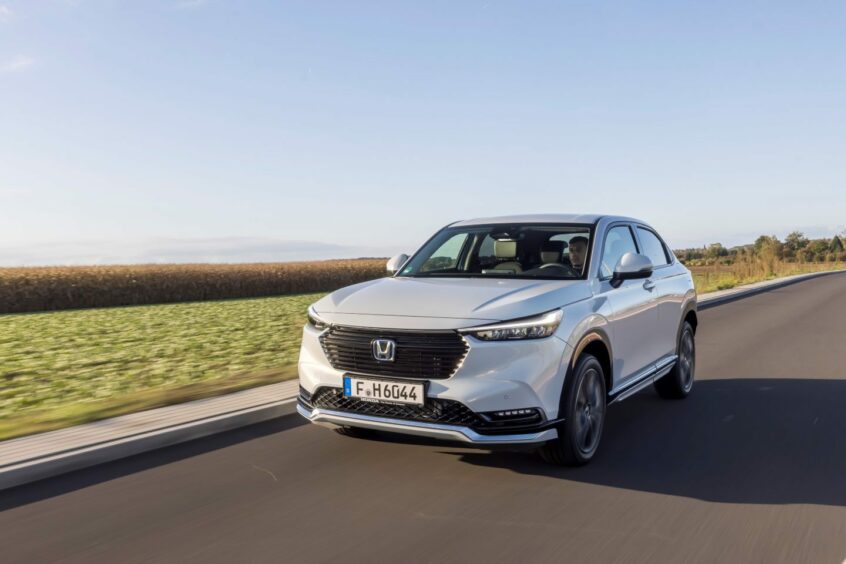The Honda HR-V has one of the most storied histories of any SUV currently on sale.
It’s been around since the 1990s and, like many of us, has gone through a variety of style changes through the decades.
The original no-nonsense car had a boxy, utilitarian shape and was feted for its practicality and reliability.
Dramatic looks and good build quality

The current third generation model has much more dramatic looks but retains the well-packaged interior and bulletproof build quality buyers have come to expect from Honda.
While rivals have tended to use diesel engines – which is now going out of fashion due to its impact on air quality – Honda has long championed hybrid power.

The current generation pairs a 1.5 cylinder petrol engine with two electric motors and a battery. It’s a self-charging hybrid, so there’s no need to run extension cables out of your window.
Economical with lower emissions
Instead the engine replenishes the battery, and it also gains charge by capturing energy generated during braking.
The result is a car that delivers diesel-like fuel economy but with fewer emissions and less noise than a traditional oil burner.

Three driving modes can be selected via a dial on the dashboard – Eco, Normal and Sport. You can also tinker with the level of regenerative braking.
This increases fuel economy by maximising the car’s electrical potential, while the additional engine braking means you can almost drive the car with just one pedal.
Official fuel economy is 52.3mpg and I found this figure to be not unrealistic over a week of mixed driving. CO2 emissions, meanwhile, are admirably low for an SUV at 122g/km.

The 0-62mph time for the HR-V is 10.7 seconds but in real world driving it feels much quicker than that.
Indeed, it’s a fine car to drive. I drove throughout the east of Scotland during my time with the Honda HR-V. At 70mph on the M90 it was as smooth and quiet as any other car in its class.
Adept at town and country driving
A relatively low ride height for an SUV means it even handles with a bit of aplomb as well. And a compact footprint coupled with light steering makes in breeze to drive around town.

Prices start at a little above £26,000 and the range-topping Active Style model I drove cost slightly less than £34,000.
For that you get faux-leather and fabric seats, heated front seats, a hands-free powered tailgate, nine-inch touchscreen, wireless charging pad for your phone, and plenty of other goodies.
Safety features
Even entry level Elegance models are well equipped, however, so you may want to save some money and go for a low or midrange model.

Whichever one you buy you’ll be getting a car with plenty of safety features. All versions of the Honda HR-V come with blind-spot monitoring, lane-keeping assistance and adaptive cruise control
I found the interior a smart and user friendly space. The touchscreen is easy to operate and there are dials and buttons for controls the driver may need to use on the move, such as the heating system and fans.
A smartly packaged interior

The Honda HR-V appears smaller than some of its rivals but a cleverly packaged interior means there’s room inside for four large adults.
Boot space isn’t great at just over 300 litres, however – the Skoda Karoq, by comparison, offers more than 500.
Strong refinement means it’s excellent on long distance journeys
A saving grace is Honda’s ‘magic seats’ system, which tumbles the rear seats completely flat at the touch of a button.
This frees up almost 1,300 litres of boot space, meaning the Honda can be hugely practical as long as you’re not using the rear seats.
Well designed and spacious
Overall the Honda HR-V is a well-designed car that has a stylish interior, clever hybrid system and lots of technology.

Strong refinement means it’s excellent on long distance journeys, yet it managed to be equally adept at town and city driving.
Add in Honda’s superb reputation for reliability and you have a car that’s very impressive indeed.
The Facts
Model: Honda HR-V
Price: £33,835.
0-62mph: 10.7 seconds
Top speed: 106mph
Economy: 52.3mpg
Emissions: 122g/km







